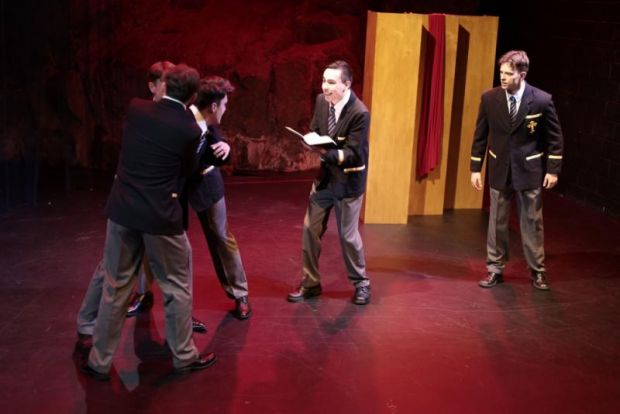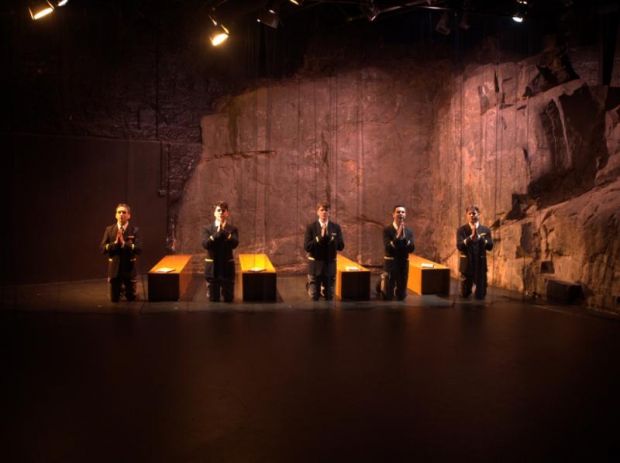Shakespeare’s R&J
The opening moments of Shakespeare’s R&J in Hobart’s Peacock Theatre – a tight montage of regimented life in a 1950s Catholic boys’ institution – launch us energetically into not just the play but the life of a new independent theatre production outfit: this is FloMo Creative’s inaugural production. On a sparsely dressed, moodily lit stage, five young men fluidly shift in and out of militant unison: reciting religious lessons, reading social etiquette guides, rote-learning maths and conjugating Latin verbs (a motif that recurs later, both humorously and emotively). This initial ensemble focus rarely flags throughout the play, during which all five actors are generous and committed.

Joe Calarco’s ‘adaptation’ of Romeo and Juliet leans principally on scenes and dialogue from the bard’s play, interspersed with snippets of the boys’ reality, asking us to draw parallels between the social restrictions enacted on these teenagers, and those enacted on the teenagers of several centuries earlier. In a practical sense, the play uses the school setting as a frame narrative to retell key aspects of Romeo and Juliet: the boys, having found a copy of the play, gather after lights-out to perform an illicit ‘reading’ of a script they at first ridicule but quickly take very seriously. Actors Andreas Tsiakis, Julius Lovell, Peter Escott, Jonty Hilton and Lachlan Ramsey are the five ‘Players’, in the roles of the unnamed boys, who each then take on various roles from the Shakespearean play, with Tsiakis as Romeo and Lovell as Juliet.
Calarco’s script demands some Shakespearean familiarity (not just with the eponymous play but also sonnets, and other plays including A Midsummer Night’s Dream) in order to fully appreciate the subtext being teased out. At times it feels as though the story Calarco really wants to tell us – a story, perhaps, of a queer coming-of-age; of pubescent tensions between kindness and a dangerously aggressive masculinity; of the repressions of religion; of the volatility of youth; and of the lure of individualism – is somewhat hamstrung by its entanglement in a Shakespeare known the world over. But at the play’s most absorbing moments, the Players slide smoothly between the two realities and Calarco achieves what he set out to: building a new narrative within an old. I do wish there were a few more of these moments.
This production is at its strongest when embracing dynamic shifts; when trusting the actors’ capacities, and the power of stillness and quiet (an eclectic soundtrack, often effective in setting mood, sometimes gets in the way of scenes); and when allowing glimpses into the awkward and raw cusp of these characters’ adulthood. The scenes are well supported by Jill Munro’s confidently spare set (a black gauze curtain – exposing the Peacock’s gorgeous rock face – and four simple, versatile wooden rostra). With minimal props, a single red cloth serves as everything from knife to blanket to vial of poison, and is also used symbolically such as to represent tensions, or the lovers’ attraction and connection. While sporadically this connotes drama-school activities for unearthing a script’s subtext, largely it is an effective, visually pleasing device that complements the simplicity of the staging.

Although there was some unevenness between performances and some points where dramatic discipline was lost, on the whole, director Jeff Kevin keeps his young cast on task. Highlights include: beautifully choreographed scenes walking a well-judged line between comedy and elegant nonverbal storytelling (such as Juliet, Lady Capulet and the Nurse synchronously sewing an imaginary tapestry); Hilton’s funny (only occasionally overdone) Nurse; and delicate tenderness between Romeo and Juliet. Looking forward to seeing what creative choices FloMo makes next.
Review by Anica Boulanger-Mashberg
Anica Boulanger-Mashberg is a Hobart-based writer, editor and reviewer.
Photography: Bob Linacre and Wayne Wagg
Subscribe to our E-Newsletter, buy our latest print edition or find a Performing Arts book at Book Nook.
